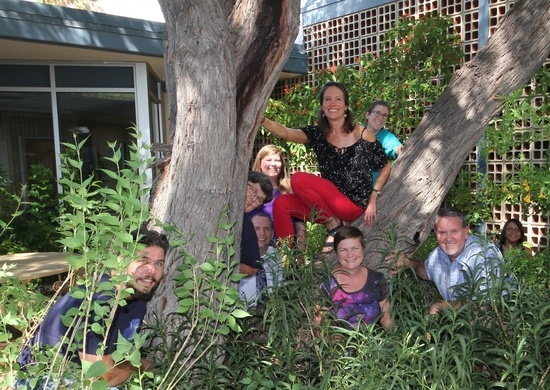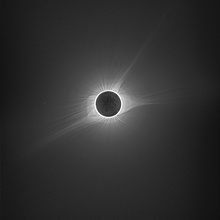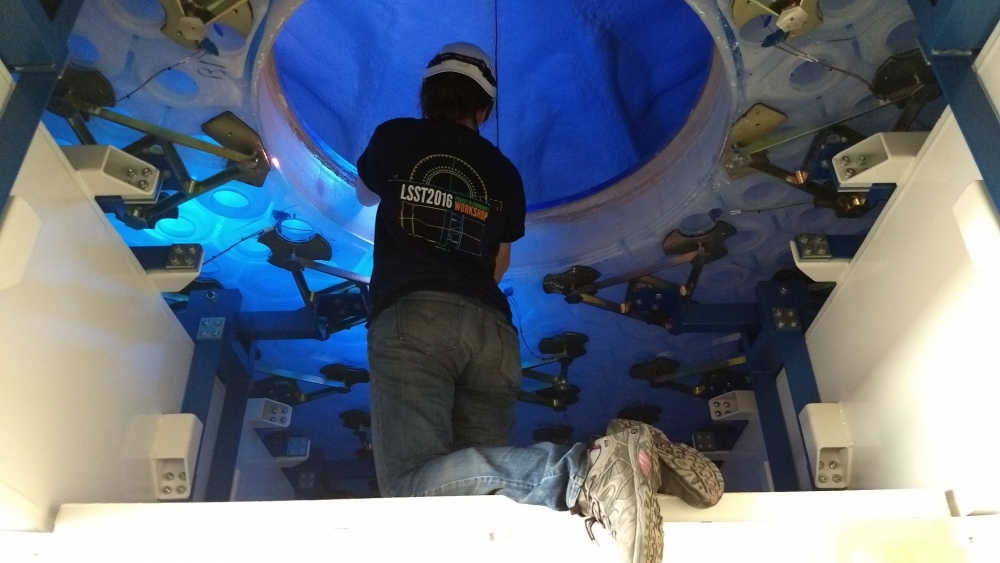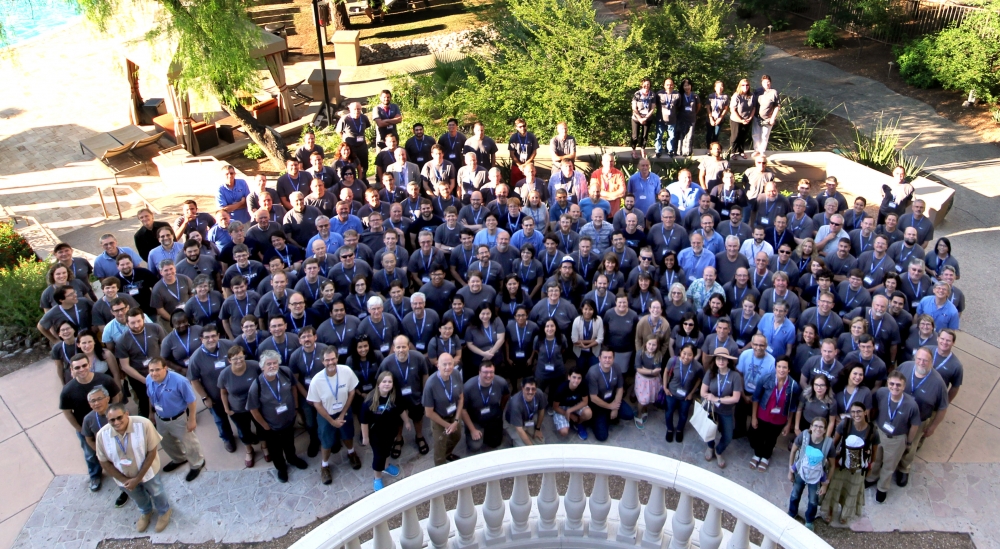LSST 2017 wrapped up on August 18th, ending a productive week of presentations, conversations, and collaboration. Over 260 participants gathered for the traditional group photo, and plenary slides have been linked to the workshop agenda.
The LSST Project Science Team is hosting a series of presentations for Science Collaboration Chairs based on topics requested by the Chairs. These presentations have been linked to our public website For Scientists page; new talks will be uploaded as they become available. If you are in a Science Collaboration and are interested in a specific topic, please get in touch with your Chair.
Two talks on LSST are scheduled for October 16 2017 at the Division for Planetary Sciences (DPS) meeting: one is on LSST as a NEO Discovery Machine, and another is on LSST Data Products and Tools for Solar System science. Meg Schwamb and David Trilling, co-chairs of the LSST Solar System Science Collaboration, are also hosting a workshop titled LSST and the Solar System on Thursday, October 19th, from 4:30 - 6:30 p.m.
Save the date: The next “A Day in the Life” video is scheduled for Thursday, Sept. 14th. Everyone working on LSST will be asked to submit a photo taken during that workday for inclusion in the video. Details for how to submit your photos will be announced soon. The first “Day in the Life” video can be viewed in the LSST Gallery.
LSST congratulates several of its team members for receiving 2017 AURA Service Awards for exemplary work on the LSST project; award winners were recognized at an event in Tucson on August 2nd. Individual awards were presented to Telescope and Site Optics Engineer Constanza Araujo, and Systems Engineering Manager Brian Selvy. A team award also went to the LSST/AURA Summit Construction Team, made up of members Eduardo Serrano, Jaime Seriche, Freddy Munoz, Jorge Flores, Sandra Romero, and Jeff Barr.
An LSST Telescope and Site team visited the Primary/Tertiary Mirror (M1M3) storage site at Tucson International Airport in early August to open the storage container and inspect M1M3 in order to plan and prepare for upcoming hardware and electrical integration activities. Read more about the visit in a recent blog post.
Summer Daylight Saving Time occurred in Chile at midnight on Saturday, August 12th, when clocks in Chile were moved forward one hour.
CORPORATION NEWS
Version 1.0 of the LSST Galaxies Science Roadmap, authored primarily by members of the LSST Galaxies Science Collaboration, has been completed and can be found at this link. The Galaxies Science Roadmap identifies preparatory science tasks for the LSST community related to galaxy formation, dark matter, and supermassive black holes. It is intended to be a helpful organizational document for scientists interested in LSST for extragalactic science beyond dark energy studies.
The LSSTC Enabling Science 2018 Call for Proposals is now open. Funding will be allocated to support programs in the following categories:
- Helping the community prepare to maximize the science impact of LSST
- Funding workshops, schools, and internships to engage and train future users of LSST
- Supporting Science Collaborations in their planning and preparations for data
- LSSTC Student Internships and Travel to LSST 2018
More information about LSSTC supported activities can be found here. Proposals should be submitted to lsstc@lsst.org by Monday, December 18, 2017.
PERSONNEL
Andrew Heyer joined the LSST Telescope and Site (T&S) Software team as a Software Analyst on August 7th. Andrew will be supporting the development of the LSST Scheduler.
Brian Stalder joined the Systems Engineering & Commissioning Team on August 7. Brian will assist in the planning, development and conduct of LSST Commissioning. He will also work in Chile to carry observations and analyses needed for the commissioning effort.
The LSST Data Management Group is soliciting applications for the position of Lead LSST Data Management Scientist (project title of LSST DM Subsystem Scientist DMSS), within the LSST Leadership Team at the LSST Project Office (Headquarters) in Tucson, AZ. View the full job posting here.
Want to spice up your work wardrobe with some team spirit? You can purchase LSST gear at our online Land’s End logo store. If you act fast, you can use code EMSAVE20 to save 20% on your order; offer ends 8/31.
UPCOMING MEETINGS with LSST INVOLVEMENT
(those with asterisk* are LSSTC funded):
2017
|
|
|
August 21-29
|
La Serena School for Data Science*
|
|
September 6 – 8
|
NSF/DOE Joint Status Review, Tucson, AZ
|
|
September 14 – 15
|
AURA Management Council for LSST (AMCL) Meeting, Tucson, AZ
|
|
September 20-22
|
NSF Site visit, La Serena, Chile
|
|
September 26-28
|
Education and Public Outreach (EPO) subsystem review, Tucson, AZ
|
|
October 19, 4:30-6:30 pm
|
LSST and the Solar System Workshop at the 49th American Astronomical Society's Division for Planetary Sciences (DPS) meeting, Provo, UT
|
|
October 22-26
|
Astronomical Data Analysis Software and Systems (ADASS) Conference, Santiago, Chile
|
|
October 26-28
|
Society of Women Engineers WE17 Conference, Austin, TX
|
|
October 27-29
|
International Virtual Observatory Alliance (IVOA) meeting, Santiago, Chile
|
|
November 30 - December 1
|
AURA Workforce & Diversity Committee (WDC), Baltimore, MD
|
2018
|
|
|
January 8-12
|
American Astronomical Society (AAS) 231st Meeting, National Harbor, MD
|
|
January 10
|
LSST Town Hall at AAS 231, 7:30 pm
|
|
February 5
|
Dark Energy School, SLAC, CA
|
|
June 10-15
|
SPIE Astronomical Telescopes and Instrumentation Meeting, Austin, TX
|
Proyecto & SCIENCE NEWS
LSST 2017 Termino el 18 de Agosto, finalizando una productiva semana de presentaciones, conversaciones y colaboración. Más de 260 participantes se reunieron para la tradicional foto grupal group photo, y las diapositivas de las plenarias se han vinculado a la agenda del taller.
El Equipo Científico del Proyecto LSST está organizando una serie de presentaciones para la Presidencia de la Colaboración Científica basadas en temas solicitados por los Presidentes. Estas presentaciones han sido vinculadas a nuestro sitio web público, en la página Para Científicos For Scientists; nuevas charlas serán subidas a medida que estén disponibles. Si eres parte de una Colaboración Científica y estás interesado en un tema específico, por favor, ponerse en contacto con tu Presidencia.
Dos charlas sobre LSST están programadas para el 16 de Octubre, 2017 en la reunión División de Ciencias Planetarias (DPS): una es sobre LSST como una Maquina NEO Discovery, y la otra es sobre Productos de Datos LSST y Herramientas para la Ciencia del Sistema Solar. Meg Schwamb y David Trilling, co-presidentes de la Colaboración Científica del Sistema Solar LSST, también presentaran un taller titulado LSST y el Sistema Solar el jueves, 19 de octubre, de 4:30 - 6:30 p.m.
Guarda la fecha: El próximo video "Un Día en la Vida" está programado para el Jueves 14 de Septiembre. Se les pedirá a todos los que trabajan en LSST enviar una foto tomada durante la jornada de trabajo para su inclusión en el vídeo. Los detalles de cómo enviar tus fotos serán anunciados pronto. El primer video de "Un Día en la Vida" puede visualizarse en la Galeria de LSST LSST Gallery.
LSST felicita a varios miembros del equipo por recibir Premios por Servicio de AURA 2017 por su ejemplar labor en el proyecto LSST; los ganadores del premio fueron reconocidos en un evento en Tucson el 2 de Agosto. Premios individuales fueron presentados al Ingeniero Optico de Telescopio y Sitio, Constanza Araujo y al Gerente de Ingeniería de Sistemas Brian Selvy. Un premio de equipo también se le otorgo al Equipo LSST/AURA de Construcción de la Cumbre, compuesto de los miembros Eduardo Serrano, Jaime Seriche, Freddy Muñoz, Jorge Flores, Sandra Romero, y Jeff Barr.
Un equipo de Telescopio y Sitio de LSST visitó el sitio de almacenamiento del Espejo Primario/Terciario (M1M3) en el Aeropuerto Internacional de Tucson a principios de Agosto para abrir el contenedor de almacenamiento e inspeccionar el M1M3, a fin de planificar y prepararse para las próximas actividades de hardware e integración eléctrica. Lee más sobre la visita en un reciente blog post.
El Horario de Verano en Chile comenzó la medianoche del Sábado 12 de Agosto, cuando los relojes en Chile se adelantaron una hora.
Noticias de la Corporación
La versión 1.0 de la LSST, escrito principalmente por miembros de la Colaboración Científica de Galaxias LSST, se ha completado y puede ser encontrada en este vínculo at this link. La Guía de Ciencia identifica tareas de ciencia preparatoria para la comunidad LSST relacionadas con la formación de una galaxia, la materia oscura y agujeros negros súper masivos. Está destinado a ser un útil documento de organización para los científicos interesados en LSST para la ciencia extra galáctica más allá de estudios de energía oscura.
La Llamada a Propuestas 2018 2018 Call for Proposals de LSSTC Enabling Science está ahora abierta. La financiación se destinará a programas de apoyo en las siguientes categorías:
- Ayudar a la comunidad a prepararse para maximizar el impacto a la ciencia de LSST
- Financiación de talleres, escuelas y pasantías para captar y formar a los futuros usuarios de LSST
- Apoyar a Colaboraciones Científicas en su planificación y preparativos para los datos
- Pasantías de Estudiantes LSSTC y Viajar a LSST 2018
Más información acerca de actividades apoyadas por LSSTC puede encontrarse aquí here. Las propuestas deberán ser presentadas a lsstc@lsst.org antes del Lunes 18 de Diciembre, 2017.
Personal
Andrew Heyer se unió al Equipo de Software de Telescopio y Sitio (T&S) de LSST como Analista de Software el 7 de agosto. Andrew apoyara el desarrollo del LSST Scheduler.
Brian Stalder se unió al Equipo de Ingeniería de Sistemas y Puesta en Marcha el 7 de agosto. Brian ayudará en la planificación, el desarrollo y conducirá la puesta en marcha de LSST. También trabajará en Chile para realizar observaciones y análisis necesarios para el esfuerzo de la puesta en marcha.
El Grupo de Gestión de Datos de LSST está solicitando postulaciones para el puesto de Científico Principal de Gestión de Datos (título del proyecto de Científico LSST del Subsistema DM DMSS), dentro del Equipo de Liderazgo de LSST en la oficina del proyecto de LSST en Tucson, AZ (Sede). Ver la oferta de trabajo completa aquí here.
Desea animar tu vestuario de trabajo con espíritu de equipo? Puedes comprar ropa LSST en nuestra línea de Land's End logo store. Si actúas con rapidez, puedes usar el código EMSAVE20 para ahorrar un 20% en tu pedido; la oferta termina el 8/31.
Próximas reuniones con participación de LSST
(aquellos con un asterisco* son financiados por LSSTC):
2017
|
|
|
Agosto 21-29
|
Escuela de Ciencia de Datos La Serena *
|
|
Septiembre 6-8
|
NSF/DOE Joint Status Review, Tucson, AZ
|
|
Septiembre 14-15
|
Reunión del Consejo de Administración de AURA para LSST (AMCL), Tucson, AZ
|
|
Septiembre 20-22
|
Visita al Sitio de la NSF, La Serena, Chile
|
|
Septiembre 26-28
|
Revisión del Subsistema de Educación y Difusión Pública (EPO), Tucson, AZ
|
|
Octubre 19, 4:30-6:30 pm
|
Taller de LSST y el Sistema Solar en la Reunión 49 de la Sociedad Astronómica Americana de la División de Ciencias Planetarias (DPS), Provo, UT
|
|
Octubre 22-26
|
Conferencia Astronomical Data Analysis Software and Systems (ADASS), Santiago, Chile.
|
|
Octubre 26-28
|
Conferencia Sociedad de Mujeres Ingenieros WE17, Austin, TX
|
|
Octubre 27-29
|
Reunión Alianza Internacional de Observatorios Virtuales (IVOA), Santiago, Chile.
|
|
Noviembre 30 – Diciembre 1
|
Fuerza Laboral & Comité de Diversidad de AURA (WDC), Baltimore, MD
|
2018
|
|
|
Enero 8-12
|
Reunión 231 de la American Astronomical Society (AAS), National Harbor, MD
|
|
Enero 10
|
LSST Town Hall en AAS 231, 7:30 pm
|
|
Febrero 5
|
Escuela de Energía Oscura, SLAC, CA
|
|
Junio 10-15
|
SPIE Reunión de Telescopios Astronómicos e Instrumentación, Austin, TX
|











